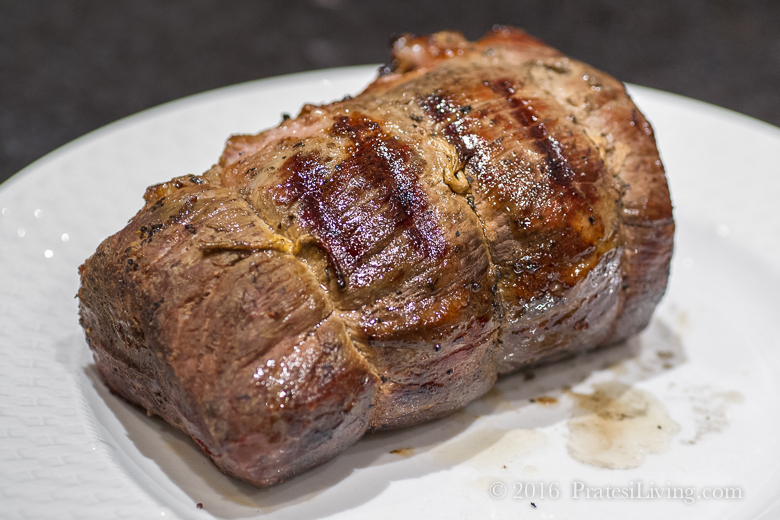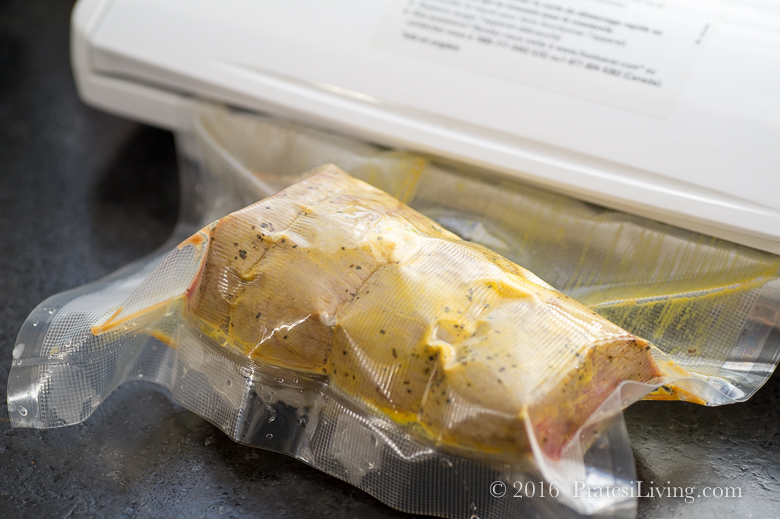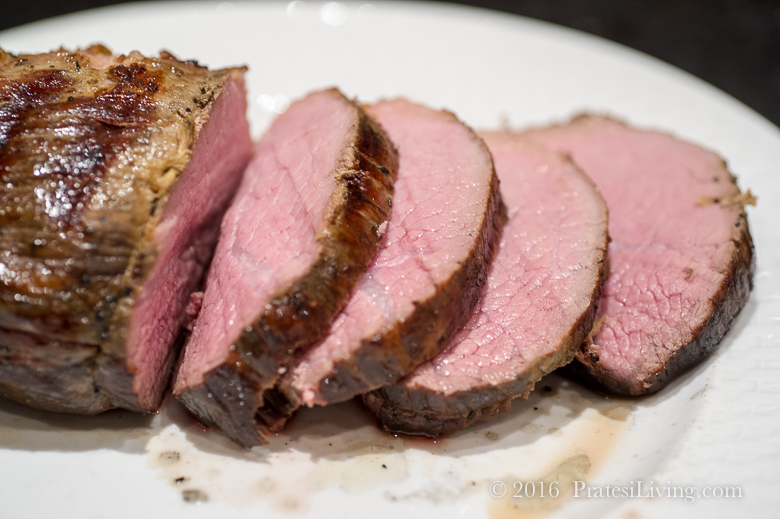12 Important Tips for Sous Vide Success

I’ve written several articles about sous vide, cooking under pressure in a water bath. Today, I want to share some lessons learned through working with the concepts created by the corporate chef at PolyScience, a pioneer of sous vide equipment, other chefs around the country, and my own use of the equipment. Some of these lessons will be controversial to some as I have found in reader responses in other articles I’ve penned. These recommendations rely on both science and experience.
First, let’s be sure we are all on the same page about sous vide. Sous vide is a technique that seals food in a vacuum bag and the bag is placed in a warm/hot water bath for a period of time to allow the warm/hot water to cook it. Using this technique, a medium rare roast can be 130 degrees from edge to center, or the level of doneness that you wish. This is achieved by setting an immersion circulator to the exact temperature you wish to achieve and leaving it in the bath based on standard charts available to tell you time for specific foods. For most proteins, leaving it longer will improve the tenderness, to a point. You can learn more about what to consider when buying a sous vide in this article, What You Need To Know Before Buying a Sous Vide for the Home.
Top 12 tips for sous vide success
1. Cover the water bath with either a lid designed for the container with a cutout for the sous vide electronics or with plastic stretch wrap. The warm water evaporates as it’s circulated through the tank of water. Many people use large stock pots for the water bath with the immersion circulator attached to the inside. As hours pass by, the water evaporates. The evaporate will collect on the electronics of the sous vide machine and will also reduce the depth of the bath, resulting in damage to the unit if it evaporates below the heating coils or circulator motor. Covering it with plastic wrap will return the condensate to the bath and prevent loss of the evaporate. It will also better hold heat in the water bath. This is most important for extended sous vide cooking.

Cover the container with plastic wrap
2. Carefully select the herbs and seasonings that you use in the vacuum bag during sous vide. Certain herbs will overpower the flavor and even taste rancid if left too long in the bag with the meat and veggies. Garlic, black pepper that has been pre-seared with the meat, cumin, and other strong spices and herbs will intensify the flavor in the bag. Fresh herbs like thyme, garlic, onion can change taste so cut back on your initial flavoring. Dried herbs seem to do better in the cooking process than fresh ones do.

Be careful not to add too many strong seasonings to the foods when using sous vide
3. Assure that the vacuum seal is tight so there are no air gaps between the meat/food being prepared and the plastic bag. Air gaps can result in uneven cooking. The bag must be in direct content to the food. Some people have suggested using zip lock bags. If you do, you must suck the air totally out of the bag.
4. Place the stock pot or vessel you will use for sous vide on an insulated pad or trivet so as not to leave the hot water bath on an unprotected counter top. While most counter tops can handle the prolonged heat or spilled sitting water, some will discolor, like wood, marble, and some granites. Unless you know your counter top is heat and water safe, you should protect it.
5. Assure that the bag stays immersed in the water. Sometimes, the circulator can cause the vacuum bag to pop up and down above and below the surface of the water like a fishing bobber. Usually this means there’s an air pocket in the bag and the air will rise. If the air is removed it should stay down unless you are cooking an item that is lightweight. I have had this happen with fish. The item is so light that the circulator will push it up and down. You can always add a food safe weight to an inside corner of the bag prior to sealing, away from the item being cooked.
6. Quickly sear meats prior to vacuum sealing. I’ve had many people say this is not necessary and others say this is wrong. Well, if you want to add extraordinary flavor to beef, pork, game, bison, elk, et al., then season and sear prior to sous vide. The maillard reaction between amino acids and reducing sugars created by searing drives those caramelized flavors deep into the meat as it slowly cooks in the sous vide. Is this required for sous vide? No, it’s not and truthfully, many restaurants don’t do it because it adds additional steps to the preparation process and many restaurants won’t take the time. They will simply sous vide the seasoned meat and sear it after removal from the water bath. If you want to be a food hero for your family and guests, take the extra step, it’s worth the flavor difference.

Sear your meats before the sous vide process
As a note, I do not pre-sear fish or delicate foods. Season in the bag during sous vide and sear when done. Some people use a torch for the final sear, rather than a pan.

You can also sear after the meat is cooked to the desired temperature
7. Assuming you have “pre-seared” the meat, place it in the vacuum bag and immerse the bag in an ice water bath to bring the temperature down to 38° F. (This step is not necessary if you have not pre-seared). Do not seal the bag and keep the mouth of the bag above water and open. You must bring down the temperature of the meat below room temperature. Twenty minutes is sufficient. Many people have wondered why this step is important and many have argued against it. Some have even suggested that this creates a food safety issue due to how long the meat is out of refrigeration. Let me address both issues.

Bring the temperature of the meat down before placing in the sous vide
This is not a safety issue as most meats can remain unrefrigerated up to two hours and it takes well under 30 minutes to prepare, sear, chill, and seal a “pre-seared” meat. Concerning the need to chill the meat, liquids, like meat juices, boil well below 212° Fahrenheit when under pressure. If you go from skillet to vacuum seal and a 130° water bath you will boil the food in the bag. Consider what it will taste like if you boil beef for say 30 hours or a vegetable for 40 minutes. While it will still have flavor, the texture will break down.
Another quick tip, before placing the meat in the bag, roll the top of the bag down the outside of the bag about two inches. This keeps it away from any meat, seasoning, or juices that will get in the way of the seal. Use a paper towel to assure the rolled area is dry and unroll before sealing.
8. Prior to sealing the vacuum bag, place it in the freezer for 5-10 minutes to set the juices. Most home vacuum seal systems draw air out of the bag, as well as the moisture. That moisture will prevent a proper seal if it’s in the way. Placing the bag in the freezer will set those juices and allow more control when using your vacuum sealer. Also, if possible, use a vacuum sealer with a moisture control or marinade setting. It’s not necessary but it sure makes things easier. It draws air out more gently.

Vacuum seal the meat and seasonings
9. The Two B’s or no Two B’s. Bacteria and Botulism. This is the little talked about potential with sous vide, but not something you should worry about if you properly handle and store your food. Most meat can remain unrefrigerated for up to two hours. Leaving it longer can allow bacteria to develop. Meat that has been sealed in a vacuum bag can remain in the water bath for days without a problem, however leaving it too long can allow botulism to develop. Yes, I know that sounds scary but it really isn’t if you remember to keep it under 3 days to be safe.
Meats should not remain in a vacuum more than three days. Actually, the guidelines say more but I have always used the 72-hour rule. When you remove the meat from the sous vide bath, don’t place it in your refrigerator thinking you’ll open the bag in a day or two and use it then. Open the bag, use it soon. Botulism is a toxin emitted from anaerobic bacteria, meaning it requires the lack of air to grow, like a vacuum sealed bag. If you sous vide a piece of meat for 3 days and stick it in the refrigerator for 2 days you have given the bacteria five days to develop and that’s risky. So, be safe and stay with the 72-hour rule. From the time it goes in to sous vide to the time it goes into you.
10. If 30 hours is good, 72 hours is not better. I often hear chefs and home cooks say that they are preparing a 72-hour sous vide roast. The idea is the extra time will create a more tender roast as the connective tissue breaks down. The problem, as my article, 30 Hour Sous Vide Eye of Round Roast, points out, is that you lose moisture in the meat the longer it is sous vide. Each protein has a different recommended length of cooking time, but a good general rule is no more than 36 hours.

Perfectly prepared Eye of Round Roast
There are apps (SousVide Dash, ChefSteps, Polyscience Toolbox) for the phone and online resources to help you determine proper time and temperature for various foods you wish to cook. See below for recommended temperatures.
11. For soft, fleshy foods, don’t over vacuum. Fish is a good example. Salmon is a relatively delicate fish, like sole or haddock, and when you vacuum seal the bag it’s possible to compress the flesh. You’ll end up with fish cakes and not the delicate flaky fish you were hoping to enjoy. Some vacuum sealers have a gentle cycle. Alternatively, manually turn of the vacuum and seal the bag when it has closed against the flesh but before it compresses it.

You want fish to be flaky when it’s done
12. For the Advanced Users, use two temperature settings. If you are cooking meat (pork, beef, bison, lamb, etc.), cook the protein at 120° F for 8 hours and then raise the temperature to the desired level for the remainder of the cooking time. This lower initial temperature breaks down the connective tissue better than keeping a constant temperature throughout the cooking time and you will end up with an even more tender final product.
Some Recommended Temperatures
38-43°C (100-109°F): Very rare to rare tuna
39-49°C (101-120°F): Rare to medium-rare salmon
49-55°C (120-130°F): Medium-rare to medium fish and shellfish (unpasteurized)
55-60°C (131-140°F): Beef
60°C (140°F): Pork and chicken (pasteurized)
63-65°C (145-149°F): Poached eggs
82-85°C (180-185°F): Root vegetables
Here are our other sous vide articles:
Sous Vide Salmon – PolyScience Sous Vide Professional
30 Hour Sous Vide Eye of Round Roast
What You Need To Know Before Buying a Sous Vide for the Home

This content is protected under International Copyright Laws. Pratesi Living provides this content to its readers for their personal use. No part (text or images) may be copied or reproduced, in whole or in part, without the express written permission of PratesiLiving.com. All rights reserved.
















Great sous vide tips, thanks!
I, too, appreciate your article. I just wish I could print it out to save in myown Sous Vide book. I’m just learning and want to do things correctly, so I’m putting these useful articles into a booklet for future reference.
We have just received an Immersion circulator. One question–If we were to cook a pre-seared, 4lb pork loin and didn’t vacuum seal, would we still do an ice bath to chill it before cooking sous vide? Could it cool on a counter-top for two hours?
Terrible advice on Sous Vide. Look elsewhere for expertise. For example, “ If you are cooking meat (pork, beef, bison, lamb, etc.), cook the protein at 120° F for 8 hours and then raise the temperature to the desired level for the remainder of the cooking time. ” 120 deg F is insufficient to pasteurize meat. Any bacteria present are at risk of multiplication and toxin production until bactericidal temps are reached and the bacterial toxins produced may not be inactivated even at much higher temperatures. On the other hand, many sous vide cooked foods are essentially pasteurized in their bags and have a useable lifespan of many more than three days when stored at refrigerator temperatures.
David:
You raise a fair and interesting point. To pasteurize you need to achieve at least 129 degrees for 87 minutes and that will destroy the bacteria to a safe level in the US. As noted, the low to high approach is an advanced approach for those that understand meat safety.
This approach first sears all sides of a solid muscle then proceeds with sous-vide. That searing destroys surface bacteria and a solid muscle doesn’t hold bacteria deep inside. Sous Vide at 120 degrees for 8 hours is followed by 22 hours of 132 degrees (top end of medium-rare). This elevated temperature is more than sufficient temperature and more than enough time to destroy any remaining bacteria left after the flash sear. To consider: bacteria is stable at 120 degrees and stops growing at 122 degrees.
The advantage to this approach is a slower breakdown of collagen and improved texture of the protein than can be achieved by sous vide directly at 132 degrees. Also, as noted, searing the meat prior to vacuum sealing improves flavor but it also flash kills external bacteria. When searing it is important to remember to bring the protein back to room temperature or below, otherwise you will steam the meat at 120 degrees in a vacuum. Since we are using a solid muscle and not ground meat, the FDA says there is very little chance of bacteria below the surface. Searing will flash kill the surface bacteria. It is this combination of searing, ice bath, vacuum sealing, and assuring the protein is sous-vide at 132 degrees for sufficient time that assures food safety. The 120-degree step is to avoid shocking the protein to create a less gelatinous connective tissue that occurs when brought above 125 degrees to begin with.
With regard to storing a vacuum-sealed finished protein beyond three days in the refrigerator. As noted, it is safe to store up to 5 days according to the FDA however, as mentioned, why risk it? Botulism grows in an anaerobic environment and 5 days is enough time for it to begin to develop. That’s why I personally suggest 3 days.
I got one of these cookers for a Christmas gift I do not see the point in them, it’s not that i am against a new way to cook food but it seems like a lot of waisted time searing meat then cooking it for 30 hours I don’t get it. Please help me understand it.
Robyn. Read my response just above your question. In addition to easier meal prep for large groups and perfectly cooked dishes, it’s about creating a far more tender meat. Read above.